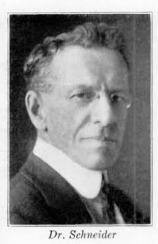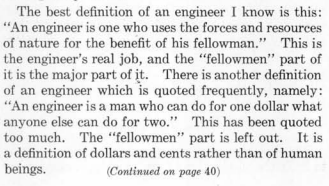We are taught that the Great Depression started with the stock market crash on October 29, 1929 or what is called “Black Tuesday”. In The Cooperative Engineer magazine, the quarterly publication of the students and alumni of the College of Engineering with its focus on industry partnered education, the word depression was not used to describe the current circumstances of the day until the October 1931 issue. Over the course of 4 issues, starting in October 1931 and running through to the June 1932 issue, the editors ran a series of “Faculty Articles” dealing with that they termed “Present-Day Trends in Problems of Commerce and Industry” or what we would now call The Great Depression.
 The first of the four Faculty Articles is a reflective piece titled “The Fourth Great Era” by Hermann Schneider, the then-current Dean of the College of Engineering and
The first of the four Faculty Articles is a reflective piece titled “The Fourth Great Era” by Hermann Schneider, the then-current Dean of the College of Engineering and

known widely as the founder of cooperative education. Schneider reflects on a talk he heard at a meeting of the Institute of Politics where the speaker argued there were
three great eras throughout history, defined by equality of legal status, religious liberty, and political liberty. The fourth era would be equality of economic status where
individuals are equal in their ability to be “masters of their livelihood”. But Schneider values engineer’s deep understanding of philosophy, art, and psychology and thinks engineers must synthesize their well-rounded knowledge to lift their fellowmen. This last bit is something Schneider thinks is too often left out of the definition of what it means to be an engineer.

In the January 1932 issue, alongside an update of the active construction of the new Physics Building, is the 2nd of the series of four Faculty Articles. In this article, titled “Our Unbalanced World”, Professor H. B. Whaling addresses the economic situation of the day and argues restoring balance to the economy is what will remedy the depressed economy. He says “At the present time the economic world is badly unbalanced and therefore badly depressed. And the immediate and pressing problem is the restoration of balance.” Whaling makes economic arguments about where the unbalance comes from and addresses various economic factors arguing that reducing tariffs will restore balance without inflating currency.

Interestingly, while “Our Unbalanced World” is the final article in the January 1932 issue, “Banking Policy and the Depression” by Professor W.P. Calhoun, is the first article in the April 1932 edition. This essay address the widespread belief of the time that the “revival of prosperity lies in a marked expansion of bank credit”. This article is lengthy, spanning three separate pages and is filled with sophisticated economic arguments and suggestions. The ending of Calhoun’s article drives home his main argument and final point: “There can be little doubt that our present difficulties are, to a very considerable extent, due, not to a deficiency of purchasing power, but to an excessive, unsound expansion of credit”.

The fourth and final in the series of four Faculty Articles is by Prof. R. R. Sharrock and titled “The Distribution Problem”. This piece is published alongside an update on the progress of the now more than half completed construction of the Cincinnati Union Terminal. Sharrock refers to distribution as the “most complex and vexing element in our present-day commercial and industrial structure”. An interesting argument Sharrock makes has to do with the lack of business data to better understand distribution trends. He argues “the flow of goods must be measured” that way tangible goals can be set with a realistic expectation of being reached. He sees this as the solution to uncontrolled production which he claims, as yet in 1932, has brought dire distress.
In the current times of pandemic, when access to the University of Cincinnati Library’s physical collections is temporarily restricted, electronic and digital resources are more important than ever as it is the only form of access the library provides. Thanks to the generous support of Michael and Margaret Valentine, the University of Cincinnati Libraries was able to digitize its collection of The Cooperative Engineer and make it publically available through the Digital Resource Commons. https://drc.libraries.uc.edu/handle/2374.UC/124
“The Cooperative Engineer was published quarterly from 1921 to 1975 by the students and alumni of the College of Engineering, University of Cincinnati. It offers primary material on the college, the campus, and the City of Cincinnati; chronicles the advancement of engineering and industrial processes in the 20th century; and gives insight into student life and social customs of the time. Original materials are held at the UC Archives and Rare Books Library.”
